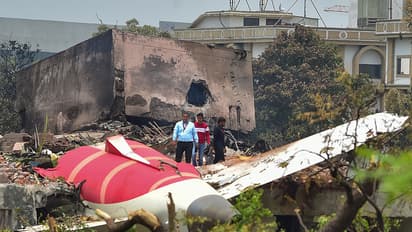Ahmedabad Air India crash: Experts suspect electrical failure, engine shutdown, and cargo overload as likely causes

Synopsis
Experts investigating the Ahmedabad Air India crash suspect possible electrical system failure, dual engine shutdown, cargo overload, or pilot error as contributing factors in the tragic Boeing 787 accident.
Mumbai: Investigations into the tragic crash of Air India flight AI 171 have sparked a range of competing theories, with many experts zeroing in on the aircraft’s advanced electrical systems. The Boeing 787 Dreamliner, a "more-electric" aircraft, replaced many traditional hydraulic and pneumatic systems with electrical ones. This shift, while efficient, has drawn new scrutiny in light of the crash.
Boom sound points to initial engine failure
The mystery began with the lone survivor's report of hearing a “boom” just after take-off , possibly indicating a partial or complete failure of one engine. In modern aircraft, a single engine failure should not cause a crash, prompting experts to ask: what else went wrong?
History of dual engine failures is rare
Globally, dual engine failures are rare, only seven have occurred over the past 70 years. Known causes include:
- Bird strikes (e.g., US Airways flight on the Hudson River in 2009)
- Wrong engine shutdowns (e.g., British Midland Flight 92 in 1989)
- Fuel starvation or contamination
In AI 171's case, bird strike has been largely ruled out, and other mechanical and operational factors are now being examined.
The B787's ‘more-electric’ design under scrutiny
The Boeing 787 Dreamliner uses electrical systems for many functions previously performed by hydraulics, including engine start, environmental control, and flight surface operation. This makes it lighter and more efficient, but possibly more vulnerable to certain kinds of failures.
One senior B787 commander noted that the boom sound likely indicated a shutdown or malfunction in one engine but asked, "What happened after that?"
Possible mistake: Was the good engine shut down?
A known cause in past crashes is shutting down the wrong engine. However, pilots noted that this process typically starts only after reaching 400 feet altitude, and the AI 171 crash occurred before that height was achieved. So while this possibility is considered, it's deemed unlikely given the timeframe.
Startle effect and pilot error considered
Some are considering the “startle effect”, where sudden shock causes involuntary actions from the crew. This might have led to:
- Forgetting to retract the landing gear
- Retracting flaps instead of gear, which affects lift
However, pilots noted that even if such errors occurred, the aircraft should still have been able to climb and circle back safely, unless both engines failed.
Variable frequency starter generators (VFSGs) under watch
A senior Airbus commander, who has also flown Boeing wide-bodies, suggested a failure in Variable Frequency Starter Generators (VFSGs). These provide the aircraft’s main electrical power and start the engines.
A VFSG failure could lead to:
- Electrical isolation
- Partial or total loss of engine control
- Failure of EECs (Electronic Engine Controls), the “throttle computers”
Without electrical power, even if the engines are running, they can get stuck at idle thrust, leaving the pilots unable to accelerate.
Could the APU have saved the aircraft?
The Auxiliary Power Unit (APU) is a backup power source but takes over 90 seconds to spool up and begin supporting flight. Since the AI 171 incident unfolded in just 32 seconds, pilots argue the APU wouldn’t have had time to intervene.
Early DGCA findings point to electrical failure
Senior pilots have referenced early findings from DGCA safety directives issued the day after the crash. These point to a potential electrical systems malfunction, which might have compromised engine responsiveness and control authority.
Was the Ram Air Turbine (RAT) deployed?
Another clue may lie in the possible deployment of the RAT (Ram Air Turbine): a small, emergency wind-powered turbine that provides basic electrical power. Pilots observed a dark patch under the aircraft, suggesting RAT deployment.
However, the RAT is not capable of providing sufficient power to control the aircraft fully, it only powers basic flight controls, not enough to maintain normal operation or safe landing.
Cargo overloading: A prosaic but plausible cause
Air safety expert Capt Amit Singh proposed a different theory: cargo overloading. He noted the aircraft took longer than usual to get airborne, which may point to excess weight.
Overloading could have:
- Slowed acceleration
- Affected climb performance
- Made the aircraft vulnerable if one engine failed
Incorrect weight entry may have led to low thrust
Another senior B777 pilot theorised that the pilots may have entered the aircraft’s zero fuel weight into the system, without accounting for 50–60 tonnes of fuel onboard. This would have led to low thrust settings, which, combined with an engine failure, would have made the aircraft unable to maintain altitude.
However, this idea is debated. A B787 commander countered by saying that the aircraft’s weight-on-wheels sensors would have alerted the pilots if such a mismatch occurred.
While investigations are still ongoing, a complex interplay of factors, including potential electrical system failure, engine malfunction, overloading, or even data input errors, is being considered. Pilots and regulators are closely examining every detail, especially the Boeing 787's electrical architecture, to determine if it played a key role in the AI 171 tragedy.
Stay updated with the Breaking News Today and Latest News from across India and around the world. Get real-time updates, in-depth analysis, and comprehensive coverage of India News, World News, Indian Defence News, Kerala News, and Karnataka News. From politics to current affairs, follow every major story as it unfolds. Get real-time updates from IMD on major cities weather forecasts, including Rain alerts, Cyclone warnings, and temperature trends. Download the Asianet News Official App from the Android Play Store and iPhone App Store for accurate and timely news updates anytime, anywhere.